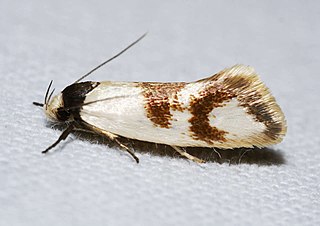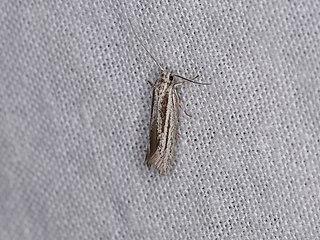
The Oecophorinae are the nominate subfamily of moths in the concealer moth family (Oecophoridae). They are part of the insufficiently studied superfamily Gelechioidea, and like their relatives, the circumscription of this taxon is disputed.

The Autostichinae are a subfamily of moths in the superfamily Gelechioidea. Like their relatives therein, their exact relationships are not yet very well resolved. The present lineage was often included in the concealer moth family (Oecophoridae), but alternatively it is united with the Symmocidae sensu stricto to form an expanded family Autostichidae.

Xyloryctidae is a family of moths contained within the superfamily Gelechioidea described by Edward Meyrick in 1890. Most genera are found in the Indo-Australian region. While many of these moths are tiny, some members of the family grow to a wingspan of up to 66 mm, making them giants among the micromoths.

Antipterna is a genus of moths of the family Oecophoridae, first described by Edward Meyrick in 1916.

Antipterna trilicella is a species of moth in the family Oecophoridae, first described by Edward Meyrick in 1885 as Ocystola trilicella. It appears to be a moth endemic to Australia and confined to the east coast, occurring in Victoria, New South Wales and Queensland.

Antipterna ptychomochla is a species of moth in the family Oecophoridae, first described by Alfred Jefferis Turner in 1940 as Antiterpna ptychomochla (sic). The species epithet derives from the Greek, πτυκομοχλοσ, meaning "with bar on fold".

Antipterna euanthes is a species of moth in the family Oecophoridae, first described by Edward Meyrick in 1885 as Ocystola euanthes, with the female lectotype being found in the Wirrabara Forest, South Australia. It appears to be a moth endemic to Australia and in addition to South Australia is also found in Victoria, New South Wales, and Queensland.
Antipterna acrobaphes is a species of moth in the family Oecophoridae, first described by Edward Meyrick in 1885 as Ocystola acrobaphes. The holotype was collected in Sydney, New South Wales, in January 1878.
Antipterna diclethra is a species of moth in the family Oecophoridae, first described by Edward Meyrick in 1885 as Ocystola diclethra. Lectotypes for both Ocystola diclethra and Machaeretis niphoessa were both collected in greater Sydney, New South Wales.
Antipterna glacialis is a species of moth in the family Oecophoridae, first described by Edward Meyrick in 1885 as Ocystola glacialis. The holotype was collected at Mount Lofty, South Australia.
Antipterna homoleuca is a species of moth in the family Oecophoridae, first described by Edward Meyrick in 1885 as Ocystola homoleuca. The lectotype for Ocystola homoleuca was collected at Wirrabara, South Australia, while that for Ocystola argophanes was collected in Brisbane, Queensland.
Antipterna monostropha is a species of moth in the family Oecophoridae, first described by Edward Meyrick in 1885 as Ocystola monostropha. The lectotype for Ocystola monostropha was collected at Blackheath, New South Wales.
Antipterna lithophanes is a species of moth in the family Oecophoridae, first described by Edward Meyrick in 1885 as Ocystola lithophanes. The lectotype for Ocystola lithophanes was collected at Deloraine, Tasmania. Holotypes for Alfred Jefferis Turner's synonyms were collected from Queensland and New South Wales.
Antipterna assulosa is a species of moth in the family Oecophoridae, first described by Alfred Jefferis Turner in 1940 as Machaeretis assulosa. The species epithet, assulosa, derives from the Latin adjective, assulosus. The holotype for Machaeretis assulosa was collected at Sandgate in Queensland.
Antipterna diplosticta is a species of moth in the family Oecophoridae, first described by Alfred Jefferis Turner in 1944 as Ocystola diplosticta. The species epithet, diplosticta, derives from the Greek, διπλοστικτος. The male holotype for Ocystola diplosticta was collected at Gladstone in Queensland.
Antipterna homopasta is a species of moth in the family Oecophoridae, first described by Alfred Jefferis Turner in 1932 as Periallactis homopasta. The species epithet, homopasta, derives from the Greek, όμοπαστος. The male holotype for Periallactis homopasta was collected at Crows Nest in Queensland.
Antipterna spathulata is a species of moth in the family Oecophoridae, first described by Alfred Jefferis Turner in 1944 as Ocystola spathulata. The species epithet, spathulata, derives from the Latin, spathulatus ("spoon-shaped"). The male lectotype for Ocystola spathulata was collected at Waroona in Western Australia.
Antipterna naias is a species of moth in the family Oecophoridae, first described by Edward Meyrick in 1902 as Machaeritis naias. The male holotype for Machaeritis naias was collected on Mount Crackenback, New South Wales. The male holotype for Ocystola paralia was collected at Brighton, Victoria.
Antipterna microphanes is a species of moth in the family Oecophoridae, first described by Oswald Bertram Lower in 1902 as Ocystola microphanes. The male holotype for Ocystola microphanes was collected at Stawell in Victoria.
Antipterna stichoptis is a species of moth in the family Oecophoridae, first described by Oswald Bertram Lower in 1915 as Linosticha stichoptis. The male holotype for Linosticha stichoptis was collected at Broken Hill in New South Wales, in a Casuarina.






